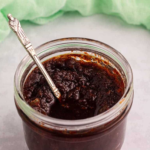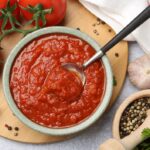In the heart of South Sudan, a land rich in culture and culinary traditions, one can find the delightful flavors of Kisra. Kisra is a traditional fermented sorghum flatbread that has been a staple in South Sudanese cuisine for generations. With its unique tangy taste, soft texture, and versatility, Kisra holds a special place in the hearts and palates of the South Sudanese people.
The Making of Kisra
Kisra is made from sorghum, a cereal grain widely grown in South Sudan. The process begins by soaking the sorghum grains in water for several days, allowing them to ferment. This fermentation process enhances the flavor and makes the nutrients in the grain more readily available for absorption. After fermentation, the sorghum is ground into a fine flour, which becomes the base for making Kisra.
The fermented sorghum flour is mixed with water to create a batter-like consistency. The batter is then poured onto a large, flat griddle or pan and cooked over low heat. The resulting flatbread has a slightly sour taste and a soft texture. Kisra can be enjoyed both hot or cold and is often served with various accompaniments, such as stews, soups, or dips.
The Significance of Kisra
Kisra is more than just a flatbread in South Sudanese cuisine; it is a symbol of cultural identity and heritage. It is a food deeply rooted in the traditions and history of the South Sudanese people. Kisra is often prepared and shared during special occasions, gatherings, and celebrations, bringing people together around the table to enjoy the flavors of their homeland.
The Versatility of Kisra
One of the remarkable qualities of Kisra is its versatility. It can be enjoyed in various ways, making it a versatile addition to any meal. The soft texture of Kisra makes it perfect for scooping up stews, curries, or sauces, allowing you to savor the flavors of the accompanying dishes. Kisra can also be used as a wrap or a base for sandwiches, providing a unique twist to traditional fillings. It can be topped with spreads, vegetables, or meats, offering a delicious and wholesome meal option.
The Health Benefits of Kisra
Kisra not only delights the taste buds but also offers several health benefits. Sorghum, the main ingredient in Kisra, is a gluten-free grain rich in fiber, antioxidants, and essential nutrients. The fermentation process enhances the digestibility and nutrient availability of the grain, making Kisra a nutritious choice. Additionally, sorghum has a low glycemic index, making it suitable for individuals with diabetes or those seeking to manage blood sugar levels.
Preserving the Tradition
As South Sudan embraces modernization, the traditional food culture, including Kisra, remains an integral part of the country’s heritage. Efforts are being made to preserve and promote the culinary traditions of South Sudan, ensuring that future generations can continue to enjoy the flavors of Kisra and other traditional dishes. By celebrating and embracing Kisra, South Sudanese people are honoring their roots and passing on their culinary legacy to the next generation.
Kisra is not just a fermented sorghum flatbread; it is a representation of the South Sudanese culture, history, and culinary traditions. Its tangy taste, soft texture, and versatility make it a beloved food in South Sudan and beyond. Whether enjoyed with stews, used as a wrap, or savored on its own, Kisra offers a unique and satisfying dining experience. So, if you have the opportunity to taste this South Sudanese delicacy, allow your taste buds to be transported to the vibrant flavors of Kisra, a true culinary gem of the region.








